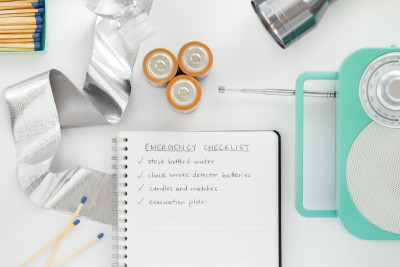In the U.S., there are about 1,251 tornadoes per year. Tornadoes can reach wind speeds of hundreds of miles per hour, destroying, trees, cars, homes and lives in their paths. And while a common myth is that tornadoes can only happen on flat land, in the right weather conditions they can actually appear in nearly any place on almost any terrain. When a tornado is present, all structures are at risk, so it’s important to be prepared for the possibility of a tornado and know safety precautions.
Prepare for a Tornado in Advance
Have a plan in place for a tornado and know where you will shelter in your home. Whether it’s a storm shelter or a closet, talk with your family about where to go. Make and keep a disaster kit in that area. Disaster kits include items like non-perishable food, water, flashlights, batteries, first aid items, needed medications, an emergency radio and more. If you have pets, plan how to get them to your designated area. Pack their food and extra water in your kit and have room for pet crates if needed.

Practice your plan to get to safety with your family regularly, pets included, to keep it fresh in everyone’s mind. Know your pets’ usual hiding spots as well, so you aren’t taking too much time searching for them before taking shelter. Also talk to your family about what to do if a tornado happens when some of you aren’t home. Make a list of possible safe places or community shelters for everyone to know.
You may also want to review your insurance policies. Tornado damage is typically covered, but storms can also cause flooding, so consider adding a flood policy as well.
Stay Alert
Be sure to sign up for emergency alerts, keep a weather app on your phone and stay tuned into the weather on the radio or TV for updates on severe weather. It’s important to know the difference between a tornado watch and a warning, as well. A watch means the conditions are right for a tornado to possibly appear. A warning means a tornado has formed and is in the area, so you need to reach shelter. Many towns have emergency or tornado sirens, so pay attention when you hear them.
Another thing to learn is the warning signs of a tornado and what they look and sound like. To see how at risk your region is for tornadoes, you can check this list and see the average number of tornadoes in your state. Just because your state isn’t known for being in “Tornado Alley” (which is often considered an outdated term now), tornadoes can still occur in your area.
Take Cover

Finding shelter immediately when a tornado warning is in effect is the top priority. Do not stay outside. Stay away from windows, and pick interior rooms on the lowest floors, such as a closet or bathroom. If you have a basement or underground shelter, take cover there. Protect yourself, especially your head from falling debris. This could mean sitting under a table or covering up with a mattress or heavy blanket.
If you are driving, do not try to outrun the tornado. If you can’t find shelter, park your car, keep your seatbelt on and get down as low as you can in the car, covering your head. Or lie down in a low area like a ditch. Stay away from electric poles and never shelter under an overpass. It’s dangerous and puts you at risk for flying debris and possibly faster winds.
Tornadoes are scary events, but knowing how to be as safe as possible can help give your more peace of mind during severe weather. You can’t prevent a natural disaster, but you can have a plan and the coverage you may need in place.
Feel More Secure with Earthquake Insurance